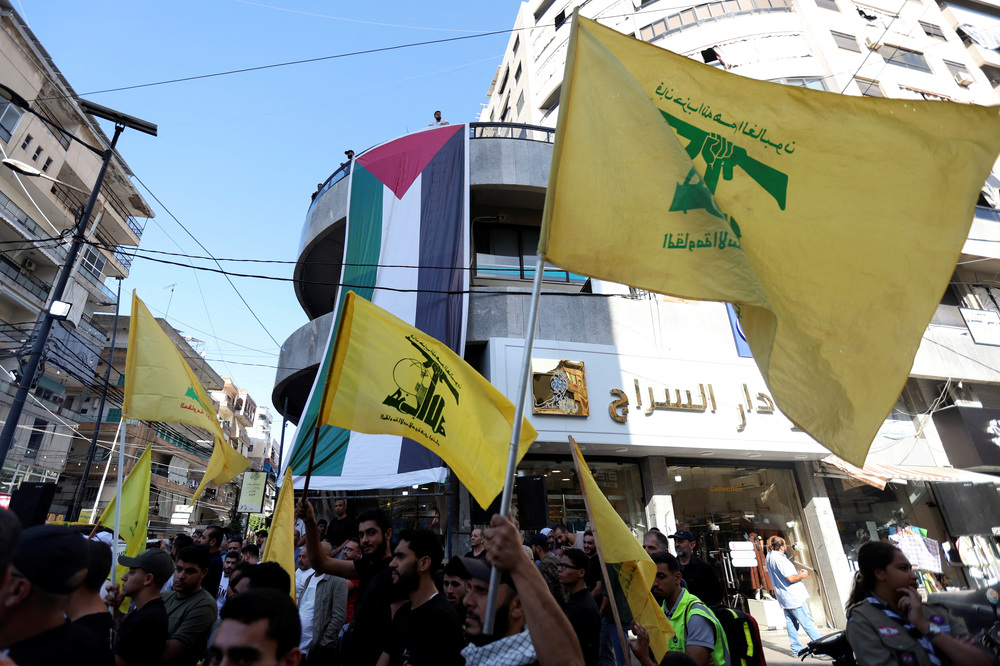
BEIRUT — The Gaza war has pushed together powerful Iran-backed Shia Muslim paramilitaries with militant Sunni factions in what appears to be closer cooperation between groups that differ in religious ideology but are united by opposition to Israel and the United States.
Hamas, which launched the attacks on Israel two months ago that sparked the war, is a primarily Sunni Muslim Palestinian movement. The group — whose name is an Arabic acronym for the Islamic Resistance Movement — is an offshoot of the Muslim Brotherhood, the powerful Islamist movement that was founded in Egypt in the 1920s.
Hamas itself was founded in 1987 by Sheikh Ahmed Yassin, a Palestinian cleric who was living in Gaza. Yassin was assassinated by Israel in 2004. The group he founded won elections in Gaza two years later and the following year seized control from the Palestinian Authority. Egypt and Israel responded by blockading Gaza.
Although Palestinians include Shia Muslims, Christians, Druze and other denominations, the vast majority are Sunni Muslims.
Groups have increased communications
Lebanese Hezbollah, a Shia Muslim movement, emerged during the country's civil war after Israel's 1982 invasion of Lebanon. Its fighters have been trained and funded partly by Iran, which uses armed proxy groups to extend its power in the region. Apart from Hamas, it poses the biggest challenge to Israel. Hezbollah and Israeli forces have attacked each other across the Lebanese-Israeli border since the war in Gaza began in October.
Both Hezbollah and Hamas are designated terrorist organizations by Israel, the United States, the European Union and others.

"I think in the recent events there is definitely more communication between these groups," says Sajad Jiyad, a Baghdad-based analyst with The Century Foundation think tank. Jiyad and other analysts pointed to recent meetings between Hamas and Hezbollah officials and Hezbollah leader Hassan Nasrallah's increasing engagement with both Shia and Sunni groups outside Lebanon.
Iran's state news agency confirmed that Iranian President Ebrahim Raisi held phone talks with leaders of Hamas and another Gaza-based armed group, Palestinian Islamic Jihad, the day after the Oct. 7 Hamas attack. IRNA said Raisi told Ziyad al-Naklhalah, head of Palestine Islamic Jihad, that God had promised the liberation of Palestine.
Jiyad also said Iranian weapons routed through Iranian proxies in Lebanon and Iraq to militant Palestinian groups also showed coordination before the war in Gaza began.
Hamas' former leader, Khaled Mishaal, told the Saudi news channel al-Arabiya that while Hezbollah attacks on Israel across the Lebanese border were useful, the fight demanded much more.
"We shouldn't just focus on Lebanon and Hezbollah. Let's look at other countries," he said, citing Egypt, Jordan and Syria.
Egypt and Jordan have signed peace treaties with Israel that have provided those Arab countries with critical economic support from the United States and Europe. While the Egyptian and Jordanian governments are unlikely to take action against Israel, public anger in their countries as Israel flattens parts of Gaza and the civilian death toll mounts raises the risk of instability.
Iran drives an "axis of resistance"
Iran-backed groups dubbed by Iran as "the axis of resistance" include Hezbollah in Lebanon, Houthis in Yemen and paramilitary groups in Iraq and Syria. Many of those groups flourished in Iraq after the U.S. invasion in 2003, to the point where Iran-backed militias answering to Tehran are now an integral part of Iraqi security forces.

Increased attacks, most by Iran-backed forces, on U.S. targets in Iraq and Syria since the Israel-Hamas war started have prompted retaliatory U.S. airstrikes in both countries.
What are Shia and Sunni?
Shia and Sunni branches of Islam split over disagreements over who should rightfully succeed the Prophet Muhammad after his death 13 centuries ago.
Religious divisions have helped fuel civil war in countries including Lebanon and Iraq in the past, although sectarianism has often taken second place to armed struggles over power and money. Increased coordination both within militant Shia and Sunni groups and between each other could represent a more potent threat to both Israel and the United States.
The Shia-Sunni split in Islam has also played a role in the regional power struggle between Iran, a Shia Muslim theocracy, and Saudi Arabia, which views itself as the leading Sunni Muslim power.
Earlier this year, China brokered a historic agreement between Iran and Saudi Arabia in which the two rivals agreed to resume diplomatic relations.
Hezbollah begins to fill a role left by slain Iranian commander Soleimani
Since the U.S. killing of Iranian commander Qassim Soleimani in a Baghdad drone strike in 2020, analysts say Hezbollah leader Hassan Nasrallah has played more of a coordinating role in bringing together divided Shia armed groups and reaching out to Sunni ones — a role at which the Iranian general excelled.
On the Lebanese side of the 30-foot concrete wall built by Israel and stretching for miles along the border of the two countries, an image of Soleimani has prominent pride of place among figures locals deem heroes of the Palestinian and Lebanese resistance.

"Certainly there has been more planning, meetings and discussion taking place with Hezbollah as a central node in the axis," says Sanam Vakil, director of the Middle East program at Chatham House research center.
She says many militant groups have mostly domestic aims in the countries where they operate and there is not yet a transnational axis of militant organization.
"There's no joint training, there's no sort of axis of resistance reunion every year in Tehran or Beirut," Vakil says. "The groups are really quite dispersed and very interested in their local context."
Sajad says he believes militant groups, willing to help Hamas but reluctant to enter all-out war with Israel, were waiting.
"I don't think Hamas has requested that sort of wider escalation or direct support but that potential is there," he says. "It really depends on how the war in Gaza proceeds."
Jawad Rizkhallah contributed to this story in Beirut.







